 Climate Action Mondays: slow fashion
Climate Action Mondays: slow fashion
Written By:
- Date published:
9:54 am, April 4th, 2022 - 44 comments
Categories: activism, climate change, sustainability -
Tags: climate action, climate action mondays, slow fashion
We are in the long emergency, the ground of which is the climate and ecological crises. This requires change across all sectors of our communities if we are going to have any chance at averting the worst case scenarios (6C rise in global temperature means extinction for most of life on the planet). We urgently need to drop greenhouse gas emissions as well as adopt sustainable and regenerative practices in all the ways we live our lives and manage society. We cannot afford to wait for governments to take action fast enough, but we need governments to act as well. The good news is people are already leading the way, and government will follow when there are enough of us.
Fashion is one area that affects anyone who wears clothes. The clothing industry is highly polluting and unsustainable, from sourcing materials, to manufacture, to generating waste. Slow fashion is the movement that antidotes the worst excesses of consumerism. Slow, so that we stop buying and wasting so much and in turn lessen the extractive and polluting demand on the natural world.
The problem, outlined in a Spinoff piece last year by business woman Bernadette Casey in A global avalanche of used clothing is coming. NZ needs to do more to save it from landfill,
As an industry, clothing and textiles are up there with agriculture and oil and gas as the top three sources of carbon emissions worldwide. Clothing production has doubled in the last 15 years to more than 100 billion units per year, and as “fast fashion” has become the norm, clothing durability and utilisation (the number of times an item is worn) have declined over the same period. Only a tiny fraction of this global fabric avalanche is ever recycled, with the bulk flowing to landfill where it releases up to three times its weight in greenhouse gases. Meanwhile the draw on virgin natural resources to replace those landfilled textiles keeps on increasing.
In addition, there is pollution from processing and dyeing textiles, significant microfibre leakage into waterways from laundry, gross inequity for workers across the supply chain (wages and conditions), and clothing ‘miles’. Here’s merino clothing pioneers Icebreaker’s supply chain – the tshirt made with wool from the South Island high country and being worn on the streets of Christchurch, has been on a quite a journey,
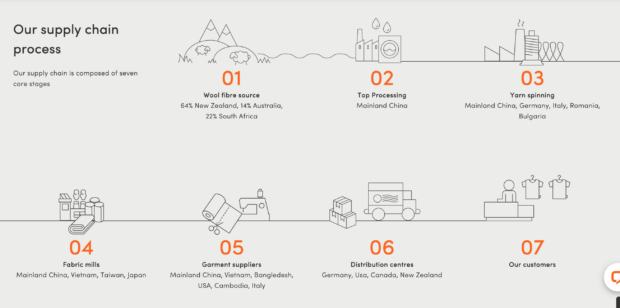
In New Zealand, we outsource much of our pollution and social injustice because we manufacture so little clothing here now. Other people and other ecosystems are paying the costs of our cheap, fast clothing. Neoliberalism initiated this in the 1980s when we closed many clothing manufacturing here, and we still haven’t seen the glorious trickle down to the people working in factories in poorer countries than ours. Icebreaker for instance are doing a lot of ‘heading in the right direction’ stuff, but I couldn’t find anything in their documents about a decent wage for workers.
The solutions
The good news is that it’s not technologically difficult to change – the challenges are behavioural and economic. We already have people making those changes from individual commitments to community initiatives to creative business leaders pushing ahead.
From Wikipedia,
Slow fashion is a concept describing the opposite to fast fashion and part of the “slow movement“, which advocates for manufacturing in respect to people, environment and animals. As such, contrary to industrial fashion practices, slow fashion involves local artisans and the use of eco-friendly materials, with the goal of preserving crafts and the environment and, ultimately, provide value to both consumers and producers.[1]
At the higher tech end, Bernadette Casey above is part of the team at Usedfully,
… a low carbon clothing system where textiles are utilised to their full potential through technology and cutting edge research – Working together with industry partners, we are driving the reuse of unwanted clothing and textiles, preventing them from going to landfill, and instead creating a circular system that fully utilises this untapped resource.
This model shows how the industry could work differently. Of note is the circular nature and relatively ‘closed loop’ (a key sustainability principle) whereby materials are cycled many times before they can no longer be used in this industry. Industrial recycling is a smaller component than reuse, repair and repurpose. If we were using predominantly natural fibres, end use would be sustainable too (eg composting)
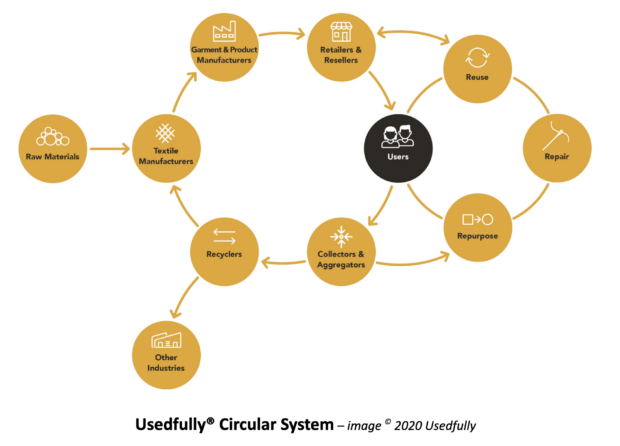
Also of note is how much of that is contained in the user end. This is where the community shines, with the emerging repair cafe and visible mending movements. Repair is the new black, along with challenges to own less clothes and wear them longer.
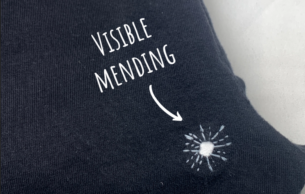
Mending movements often take inspiration from traditional Japanese mending art forms Boro and Sashiko, where visibility of the mend is valued and even highlighted. Also valued is the ability to keep a cherished piece of clothing going, sometimes for generations. Such mending can make a garment stronger and more functional over time (hand stitching is often more resilient than machine stitching), in contrast to fast fashion’s kaupapa of deterioration and replacement.
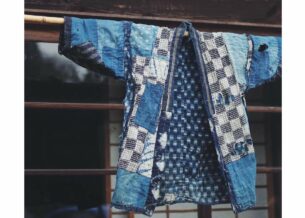
Such techniques grew naturally out of a time when fabrics needed to last much longer, and where poorer people had less ability to replace clothing. There is a merging here of past and future, and where we can take the best of the past and current tech and create a future based in land and people care values rather than extract and pollute.
Repair cafes are popup or regular events where menders and the public come together and stuff gets made functional again. They’re usually free and happening all over New Zealand. People adore them, because they either bring a well-loved object back to life, or the repair and reuse makes us feel good.
A subgenre is mending events, where people bring clothing, cushions, soft toys to either Repair Cafes, or mending classes. Professional mender, Australian Erin Lewis-Fitzgerald,
When multiple friends sent her links to a New York Times story about the Repair Cafe movement, where volunteers with repair skills offer their time and tools to people who need stuff fixed, Lewis-Fitzgerald realised it was a perfect fit. She signed up and kick-started a series of projects.
“At one of the pop-up events I did, the barista had a hole in his pants. I fixed it and posted a picture on Facebook, then the next week 13 people came in with the same problem. The most excited group were 20-somethings and they really, really wanted to learn. So I started teaching workshops and taking mending commissions on Instagram.”
Two keys for both industry and artisans are transparency in supply chains and product stewardship (ownership of pollution). Transparency means customers get to see where their clothing is made, and, depending on the degree of transparency, the quality of environmental and worker justice.
One Wellington company committed to this is Little Yellow Bird,
I started Little Yellow Bird because I wanted to know who made my clothes. The more I learnt, the more I understood how everything needed to change – from the cotton seed and the dye systems, to water usage and disposal. Therefore every aspect of our production from farm to factory is traceable and every decision we make is made with ethics at the core. We are constantly pushing ourselves to find more innovative solutions to improve the industry, and ourselves.
LYB take back end of life cotton clothing for upcycling and local recycling. This kind of closing the loop in turn encourages manufacturers to make clothing that can be mended, reused, upcycled and ultimately recycled.
What the government can do.
Usedfully says we need regulation: Recommendations to the New Zealand Government from the Clothing & Textile Industry
- Include funding for responsible disposal of the textiles it procures in its contracts
- Add textiles to the existing list of waste reduction priorities by adding synthetic fibre products to the plastics category and natural fibres to organics
- Co-invest with the private sector to establish commercial scale regional infrastructure for textile waste sorting and processing
- Mandate product stewardship schemes on all textile products
- Use subsidies and tax levers to enable recycled textiles to be competitive with virgin materials to incentivise re-use (in line with the Tax Working Group recommendations on “green taxes”)
- Set a time frame for banning textiles from landfill (following Europe’s example)
Greenpeace International are pointing to the need for regulation. Ten years on from their Detox My Fashion campaign aimed at removing harmful chemicals from textile work places and preventing environmental pollution, this report last year showed that the industry cannot be relied upon to self regulate.

The other urgent area is rebuilding New Zealand’s manufacturing industry, including small and medium businesses. This 2020 Stuff report, There are just no young people: New Zealand clothing manufacturers sound alarm, talks about the decline since the 80s, and the challenges to the industry currently including from the aging population who hold the skills but won’t be around forever. One solution is to increase the apprenticeship scheme so that it is attractive to young people. We need designers, but also the people to do the actual making, as well as those who maintain the machinery.
At this point New Zealand then comes up hard against our reliance on cheap imports. How do we afford the real cost of clothing? Certainly needing to buy less makes a big difference. But we also need to solve fast fashion alongside core social problems like wages and benefit rates and housing costs.
The other political issue is how to make these changes last culturally, a kind of fad-proofing where we don’t move onto the next cool thing. The extent to which we make slow fashion Just Transition values-based rather than a ‘fashion’ or primarily a profit motive, and how much we can integrate the practices into everyday life, local jobs and industry will determine how successful we are.
Thanks to Shanreagh and Belladona for the New Zealand examples.
I can’t wait anymore, for whatever we are waiting for (covid to be over, the government to lead on climate action, the magic pixies who will save the Antarctic and Arctic from heating at an ‘impossible’ rate). It’s time to act as if our lives depend on it, to make climate change and ecological systems the context of everything we do.
If you want to argue about abstract ideas about climate, please do that somewhere else (try Open Mike).
If you want to do something about climate change and the ecological crises, please join the conversation below.
Needless to say, I don’t allow climate denialism of any kind under my posts. That includes arguing the Bart defense (‘humans didn’t do it’), or the Gosman defense (BAU capitalism must reign supreme/change is too hard) or the McPherson defense (‘it’s too late’).
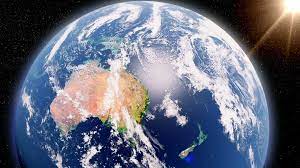
I’m with her ^^^
44 comments on “Climate Action Mondays: slow fashion ”
- Comments are now closed
- Comments are now closed
Icebreaker stuff lasts forever. And they appear to have dumped the nylon-core-merino-wrap fibre.
Do you mean lasts forever in a 'good' or 'bad' way?
Good. It's still mostly merino. I've still got items from my first Tongariro Crossing 20 years ago. And in winter you can run in their base layer.
Merino though, are sheep. Sheep farming, as it's done here, is a disaster for the kind of environment we need to foster for the future. Beautiful fibre, for sure, but sheep husbandry must change significantly.
can't see any reason why we can't do sheep farming regeneratively (leaving aside the issue of whether hooves should be here at all). Curious now if that would work with merino and the high country.
By "regeneratively" do you mean, "in a fashion that allows sheep farming to continue without crashing"?
How is that good, if the very presence of sheep and sheep farms is a significant loss to the environment, including the modified environment that might otherwise support far, far more than sheep, farmers and "the economy"?
by regeneratively I mean systems that regenerate over time, including building soils and increasing biodiversity. So no, I don't mean "in a fashion that allows sheep farming to continue without crashing"?
Wool is such a useful fibre. I'd be getting rid of the export dairy cows a long time before sheep.
Sheep are just another part of the system. Unless one believes that there should be no hooves here, sheep aren't the problem, the problem is the system design.
just googled regenag sheep and got a bunch of mainstream farming hits. Was aware of the co-option going on but still surprised. Still, heading in the right direction is not nothing.
When sheep are finally husbanded appropriately, their environment will look nothing like it does today.
I agree. Exciting to imagine it.
they're definitely doing a lot of good things. Probably their biggest challenge is going to be the merino miles, not an easy one to solve in the short term.
I'm a little unclear on their 'all natural fibre; direction, because they still seem to be bringing out new tech fabrics. Maybe they are developing biodegradable lycra etc.
There must be some way to reignite the linen industry we had, while combining that with wetland regeneration. Harakeke was a durable, useful resource a century+ ago; and it grows well in wetlands which capture more carbon per m2 than forests.
I mean, while we wait for the hemp green light.
seems like there's a gap between the industry leaders/government R/D, and the new fibre growing. Looks like lack of imagination to me, but probably also values based. Natural is seen as a niche, nice to have rather than being core sustainability.
Brilliant stuff harakeke – longform article on geo.
The thing that stops it immediately replacing cotton in a domestic fibre industry is that the wonderful long fibres are densely crosslinked with hemicelluloses.
It's really only a matter of finding a treatment that breaks them up a bit (they decay to sugars), which can be achieved mechanically, with sunlight, or chemically – it shouldn't be an issue in an age when we can buy products made of steam-exploded bamboo fibre. Small amounts of harakeke denim have been produced – it is evidently exceptionally hardwearing.
Many planting uses for it too – it makes a decent crash barrier if used in roadside planting – a softer landing can save a lot of problems.
huh. Is that why the processing mills hung it outside in the 1800s, for the sun to break down the fibres?
I believe so – though of course bleaching would also be a desirable effect of that. Most NZ flax fibre was not destined for textiles however, so a finished soft fibre seems not to have been the object.
The Southland linen mill that supplied aviation linen for WW1 aircraft was using the linen flax familiar to Egypt and Europe.
There was an article in Growing Today in the '90s though, that reported harakeke fibre being processed in an Irish linen mill with superior results.
Isn't that what 'retting' does? It's a soaking process to break down the celulose around the long fibres, so they can be freely extracted, rather than being stuck together. Certainly is used for both linen flax & NZ flax (harakeke) manufacture.
It can do – and pond bacteria are pretty good at digesting hemicelluloses. With linen flax though, it seems to have been to allow an unpowered skulching process.
Nettles (Utica) are retted by leaving them lying on the grass over winter. Pretty simple.
I'd hazard a guess a very short ferment followed by UV light would do the trick.
Yes. And very natural it is too!
Next trick would be to recover the ferment liquor – flax whiskey .
.
Have you tried the Titoki liqueur?
Too spendy for my liking. Bit of an aftertaste but I thought it was pretty nice on ice. Very cool bottle too.
https://aelia.co.nz/products/titoki-crock-liqueur-500ml?
Answering Weka's question tentatively re: sun breaking down fibres. It might help… but the importance of sunlight after microbial processing is more likely to kill off said microbes and stop them eating right through your textiles – or facilitating the arrival of species than can do that.
Interesting.
A bit out of my budget I think – I've only just stretched to Hunters collection port.
Hemicelluloses are degraded by light – it causes a real headache for conservators protecting antique Maori cloaks and the like.
The re-establishment of extensive harakeke wetlands would be a genius move, Roy, and therefore unlikely to happen.
Mahinga kai requirements for mana whenua, where all sorts of materials, edible and otherwise, could be sustainably harvested from repo such as these, would be satisfied. The greatest resource, perhaps, would be eels, tuna, that thrive in wetlands. Carefully managed and intelligently marketed – a winner all round! The fibres from the harakeke, along with the healing jellies etc. that are produced by the harakeke, are pure NZ/Aotearoa gold, in my view.
Unlikely, but not impossible. I remember when the 'flax corridor' was established on the m'way to Wellington a couple of decades ago, the idea being that it would rovide a highway of sorts for native birds. Now WTN is full of tui, riroriro and all manner of natives.
Someone must have thought it was a good idea, convinced others, got the funding, found the drive, formed a team and made it happen.
I'm thinking, the Southland Plains"
100% as well as plenty of farms all over the North Is. It was very saddening to stand on Mt Taranaki and see pathetic patches of bush among swathes of boring farms.
A great opportunity for a Minister of Ag to grow some moral fibre.
Great article and I totally agree. Coming from the Oil + Gas industry – the most polluting industry in the world, I wanted to do something that would make a difference so decided to tackle the fashion industry (one of the other most polluting industries) so I built https://ourcloset.co.nz as a way for more people to be a part of the circular economy when it comes to fashion. A place to list your own clothing and accessories for rent (and sale) and to rent/buy from others.
I was looking today, at a photograph of an ancient-but-perfectly-preserved bag, made from orb-spider web.
We are not using our imaginations enough when it comes to fibres.
I am trying nettle fibre-production, using the perennial European stinging nettle I grow here. There are on-line communities of enthusiasts showing how it's done.
Harakeke, sure, and muka is available in Southland, if you want to give it a go.
Maori raranga practitioners use a variety of fibres for different purposes, including pingao/pikao and keikei.
But for goodness sake, everyone, hemp, hemp, hemp!!! How long must it take for the penny to drop??
Myself, I've been dressing in op-shop clothes for years and years and years! Shoes too.
Ramie may be worth a look – at one time it was widely used in Korea.
Hadn't heard of ramie, Stuart, but I have now. I'll keep my eyes open for some. Collected cool-climate banana, Japanese ginger, mountain pawpaw etc. over the past couple of weeks, to try here in my Riverton tunnel house (and out-side warm-spots A new fibre plant to try would be very interesting. Thanks.
A new fibre plant to try would be very interesting. Thanks.
I ran across it reading up on Najeonchilgi – Korean lacquerware. Apparently ramie cloth was recycled into lacquer ware. It's a fascinating technology, and has some antiseptic properties as well.
On the tree thing – have you propagated myrtis ugni, the Chilean guava? Just wondering if doing so from seed or cuttings is more practical.
I have propagated Myrtis ugni from cuttings – it's a simple process and gives you an exact copy of the "mother". I'd use rooting hormone on the cuttings, if I were/was you, as your success rate will be higher. Hardwood cuttings taken in winter will do the trick, but every option is worth a try. Seed, I imagine, would be quite easy and would give you some genetic diversity and greater numbers of plants, if successful. Autumn-sown seed, exposed to the winter weather should be successful. I love those fruits and the birds don't take them.
You can also layer them, if yours is a floppy shrub.
Thanks!
Big shout out to the enlightened knitters, crocheters, spinners, seamstresses, patchworkers and so on who have known for YONKS where the future lies.
Make rope from hemp, by hand. Spanish.
https://www.facebook.com/watch?v=303472898591002
Wow sensational skills and what a privilege to have some of that rope !!
Get me some of that and I will make you a door mat !! Cheers, Keith
Keep up these posts. Lots of learning for the lurkers here.
FWIW, most of my clothes are from op-shops, but this is a time-rich activity. By that I mean every third or fourth visit, I find something to purchase. There have been bargains, virtually new NZ made shoes (McKinley), Swanndri and lined wool jersey.
At the heart of any resistance at the individual level is convenience, supermarkets and fast fashion are two examples of this
I also want to echo Robert's call for hemp, too many pros and no cons.
Cheers for the encouragement!
opshop clothing is also time consuming because clothes don’t last as long and you have to shop more often.
convenience, yep. We’re hardwired by evolution to seek the efficiencies.
Can worn out cloth be shredded and rewoven ?